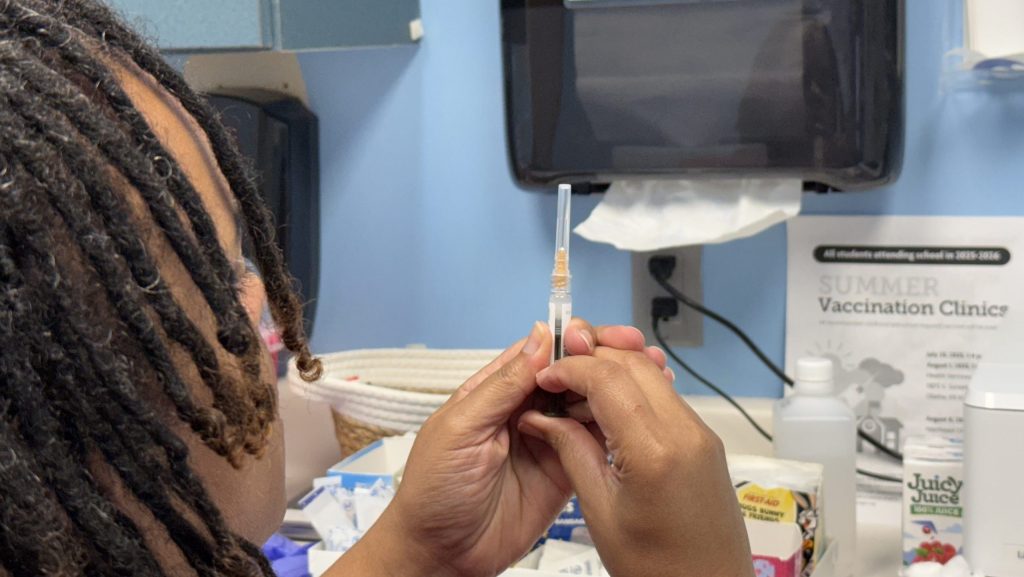"Nightmare Scenario": Kansas Schools Prepare for Measles Outbreak

The Impact of Vaccine Requirements on School Districts
School nurse Jennifer Comer recalls a particularly challenging day in 2013 when she had to exclude 289 students from Clark Middle School in Bonner Springs due to incomplete immunizations. This event highlighted the importance of strict vaccine requirements and the challenges faced by school districts in enforcing them.
Variability in Vaccine Enforcement Across Kansas
Kansas school districts have the flexibility to determine how strictly they enforce state vaccine requirements. This variability has led to significant differences in measles vaccination rates across different districts. For instance, the Bonner Springs-Edwardsville School District in Wyandotte County has the highest immunization rate, while Kansas City, Kansas, Public Schools (KCKPS) has the lowest.
The Bonner Springs district initially required vaccines but allowed families to bypass the rules. After years of pushing for stricter enforcement, the district finally took action. The process was difficult, with many families unaccustomed to the new rules. However, the results have been positive, with nearly 98% of kindergarteners at Bonner Springs schools fully immunized against measles, mumps, and rubella (MMR).
National Measles Outbreak and Local Preparedness
Despite the success of some districts, others are not as prepared. KCKPS, for example, had an MMR vaccination rate of about 67% for kindergarteners in 2023-24. Although this is improving, it remains below the herd immunity threshold. The district plans to resume enforcing its policy for the 2025-26 school year, aiming to increase compliance and reduce the risk of outbreaks.
State Vaccine Requirements and Exemptions
Under Kansas law, the Department of Health and Environment determines which vaccines are required for school attendance. The state mandates multiple doses of seven vaccines, including the MMR vaccine. There are also provisions for exemptions if a physician certifies that vaccines pose a serious risk or if a family's religious beliefs oppose vaccination. Additionally, federal laws allow children in foster care or homeless situations to enroll without all required paperwork.
Schools must notify parents of vaccine requirements before May 15 each year. While the law allows for the exclusion of non-compliant students, districts have the discretion to decide whether and when to enforce this rule.
Measles Vaccination Rates and Trends
In 2023-24, kindergarten MMR vaccination rates in Kansas varied widely. Riley County had the lowest rate at 36.67%, while the Manhattan-Ogden district had a rate of 97.27%. About one-third of districts met the 95% herd immunity threshold. However, overall vaccination rates have declined slightly over the past few years, with medical exemption rates remaining low and religious exemptions increasing significantly.
Missouri has seen similar trends, with MMR rates dropping from around 95% in 2019-20 to about 91% in 2023-24. While Missouri does not report individual district data, the overall decline mirrors Kansas' experience.
Comparing District Policies
KCKPS and Bonner Springs have different approaches to enforcing vaccine policies. KCKPS plans to give unvaccinated students 30 days to comply, while Bonner Springs requires vaccine records for enrollment. Nurses in Bonner Springs are more flexible, allowing students to start school if they show proof of an upcoming appointment or if there's a mix-up about required vaccines.
Addressing Vaccine Hesitancy
Vaccine hesitancy is becoming more common, particularly among preschoolers. Nurses like Bolewski and Comer encounter resistance from parents who may be influenced by misinformation. They work to educate families and connect them with reliable sources of information. However, concerns about vaccine safety persist, especially with figures like Robert F. Kennedy Jr., who leads the U.S. Department of Health and Human Services, questioning vaccine efficacy and promoting skepticism.
Overcoming Logistical Barriers
Beyond hesitancy, some families face logistical barriers such as language, transportation, and cost. School nurses assist by sending reminders, scheduling appointments, and providing interpreters. They also recommend local health departments and pharmacies for convenient access to vaccines.
Vaccination Events and Resources
To help families meet vaccination requirements, various health departments offer summer clinics and back-to-school events. These initiatives provide low-cost vaccinations and educational resources. For example, the Johnson County Health Department offers walk-in clinics, while the Wyandotte County Health Department hosts events specifically for students.
Preparing for Potential Outbreaks
Both districts emphasize the importance of collaboration with health departments during potential outbreaks. In the event of a measles case, schools would need to act quickly, isolating affected students and contacting health officials. The impact of an outbreak would be much less severe in districts with high vaccination rates, where most students can remain in school even if exposed.
The Broader Implications of Vaccines
Vaccines have been instrumental in preventing diseases like measles, polio, and whooping cough. However, their success has led to a lack of awareness about the risks of these diseases. Dr. Ilboudo notes that younger generations may not remember the dangers of these illnesses, making education and outreach essential.
As school districts continue to navigate vaccine requirements, the goal remains clear: to protect students and prevent the spread of infectious diseases. Through education, flexibility, and community support, schools can work toward achieving and maintaining high vaccination rates.
Post a Comment for ""Nightmare Scenario": Kansas Schools Prepare for Measles Outbreak"
Post a Comment